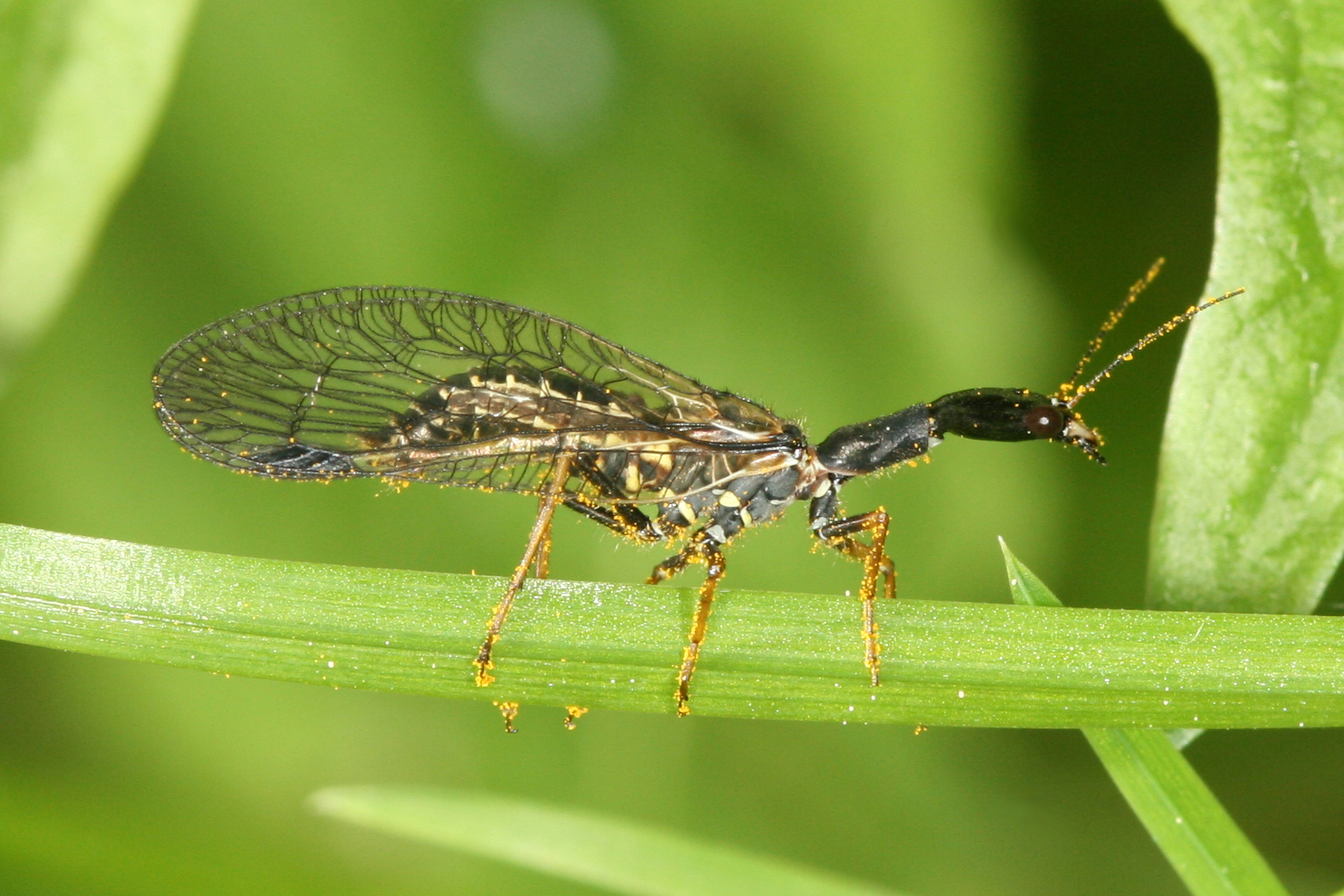|
|
| (31 intermediate revisions by 7 users not shown) |
| Line 1: |
Line 1: |
| − | {{Taxobox | + | <noinclude><translate><!--T:1--> |
| − | | color = pink
| + | </noinclude> |
| − | | name = Snakefly | + | |
| − | | image = Rhaphidiidae-sp.gif | + | <!--T:2--> |
| − | | image_width = 250px | + | {{Species id |
| − | | image_caption = ''Raphidiidae sp.''
| + | | common_name = Snakefly |
| − | | regnum = [[Animal]]ia
| + | | image = Phaeostigma notata - Raphidie - Mouche serpent.jpg |
| − | | phylum = [[Arthropod]]a
| + | | latin_name = Raphidioptera |
| − | | classis = [[Insecta]]
| + | | order = '''Raphidioptera''' |
| − | | subclassis = [[Pterygota]]
| + | | description = |
| − | | infraclassis = [[Neoptera]]
| + | Raphidioptera are characterized by having an elongate prothorax but no modification of the forelegs (as in Mantispidae). Females typically have a long ovipositor. The two extant families of snakeflies are the Raphidiidae and Inocelliidae. They are all predatory, both as adults and larvae, and in North America occur exclusively in the Western United States, but also occur throughout temperate Europe and Asia. They can be quite common. |
| − | | superordo = [[Endopterygota]]
| |
| − | | ordo = '''Raphidioptera''' | |
| − | | subordo_authority = [[Anton Handlirsch|Handlirsch]], 1908 | |
| − | | subdivision_ranks = [[Families]]
| |
| − | | subdivision =
| |
| − | [[Inocelliidae]]<br>
| |
| − | [[Raphidiidae]]
| |
| | }} | | }} |
| − | | + | <noinclude></translate></noinclude> |
| − | '''Snakeflies''' are a group of [[insect]]s in the [[order (biology)|order]] '''Raphidioptera''', which has traditionally been placed within the [[Neuroptera]] but is now generally regarded as a separate order (the traditional definition of Neuroptera included the Raphidioptera and [[Megaloptera]]; sometimes the name '''Neuropterida''' is used to refer to these three orders as a group).
| |
| − | | |
| − | Raphidioptera are characterized by having an elongate [[prothorax]] but no modification of the [[foreleg]]s (as in [[Mantispidae]]). Females typically have long [[ovipositor]]s. The two [[Scientific classification|families]] of snakeflies are the Raphidiidae and Inocelliidae. They are all predatory, both as adults and larvae, and in North America occur exclusively in the Western [[United States]], but also occur throughout temperate [[Europe]] and [[Asia]]. They can be quite common.
| |
| − | | |
| − | The order contains some 150 species.
| |
| − | | |
| − | * Family [[Inocelliidae]]
| |
| − | **Genus ''[[Inocellia]]''
| |
| − | ***''[[Inocellia crassicornis]]''
| |
| − | ** Genus ''[[Negha]]''
| |
| − | ***''[[Negha inflata]]''
| |
| − | ***''[[Negha meridionalis]]''
| |
| − | * Family [[Raphidiidae]]
| |
| − | **Genus ''[[Agulla]]''
| |
| − | ***''[[Agulla adnixa]]''
| |
| − | **Genus ''[[Dichrostigma]]''
| |
| − | ***''[[Dichrostigma flavipes]]''
| |
| − | **Genus ''[[Mongoloraphidia]]''
| |
| − | ***''[[Mongoloraphidia manasiana]]''
| |
| − | **Genus ''[[Phaeostigma]]''
| |
| − | ***''[[Phaeostigma major]]''
| |
| − | ***''[[Phaeostigma notata]]''
| |
| − | **Genus ''[[Subilla]]''
| |
| − | ***''[[Subilla confinis]]''
| |
| − | **Genus ''[[Xanthostigma]]''
| |
| − | ***''[[Xanthostigma xanthostigma]]''
| |
| − | | |
| − | ==External links==
| |
| − | *[http://tolweb.org/tree?group=Raphidioptera Tree of Life project page]
| |
| − | | |
| − | ==Further reading==
| |
| − | *Aspock, H. 2002. The biology of Raphidioptera: A review of present knowledge. ''Acta Zool. Acad. Sci. Hungaricae'' 48 (suppl 2) 35-50.
| |
| − | *{{cite book|author=[[David Grimaldi|Grimaldi, D.]] and [[Michael S. Engel|Engel, M.S.]] |title=Evolution of the Insects|year=[[2005]]|publisher=[[Cambridge University Press]]|id=ISBN 0-521-82149-5}}
| |
| − | *Carpenter, F.M. 1936. Revision of the nearctic Raphidiodea (recent and fossil). ''Proc. Amer. Acad. Arts Sci.'' 71: 89-157.
| |
| − | | |
| − | | |
| − | {{commons|Category:Raphidioptera}}
| |
| − | | |
| − | [[Category:Neoptera]]
| |
| − | | |
| − | [[de:Kamelhalsfliegen]]
| |
| − | [[fr:Raphidioptera]]
| |
| − | [[no:Kamelhalsfluer]]
| |
| − | [[pl:Wielbłądki]]
| |

